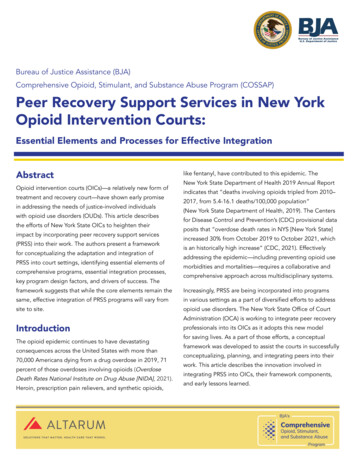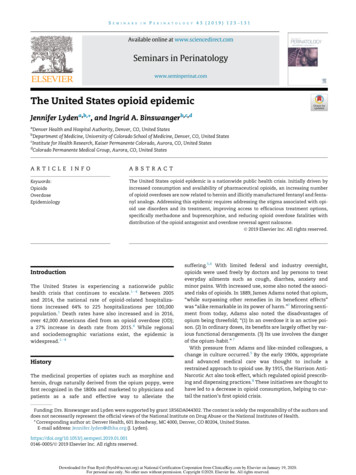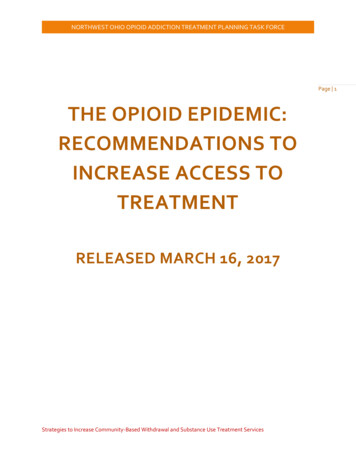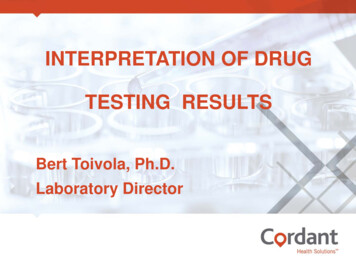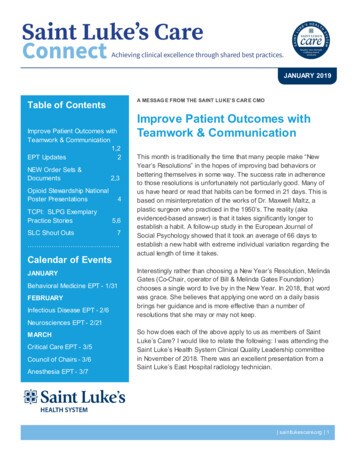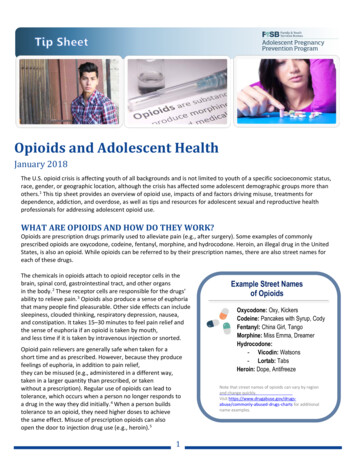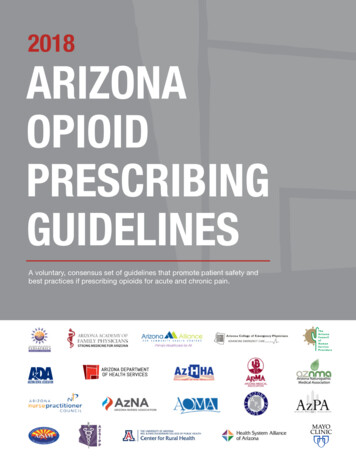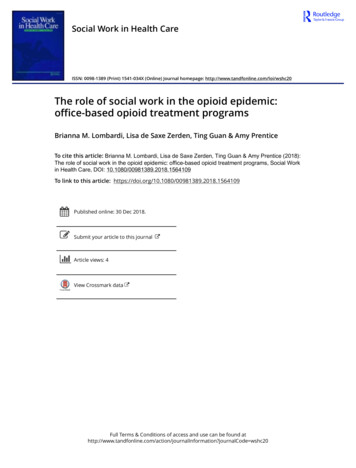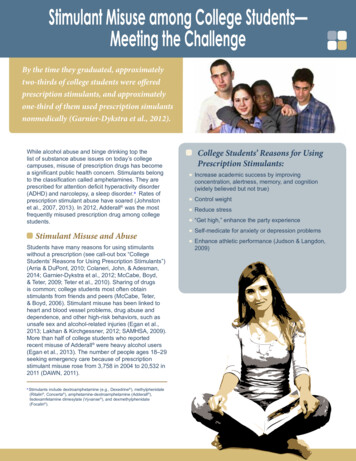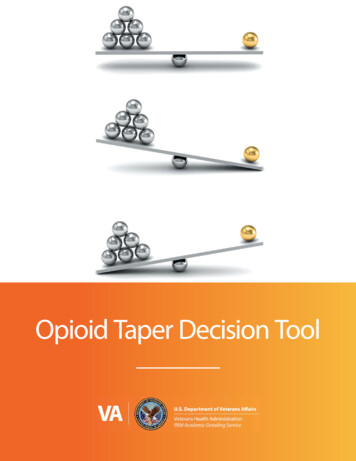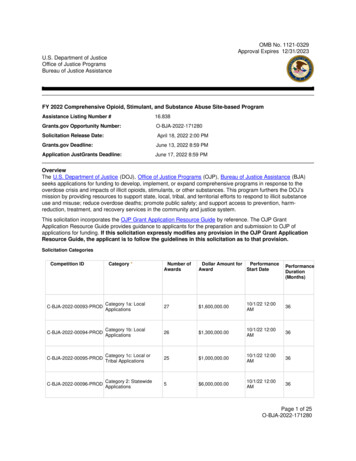
Transcription
OMB No. 1121-0329Approval Expires 12/31/2023U.S. Department of JusticeOffice of Justice ProgramsBureau of Justice AssistanceFY 2022 Comprehensive Opioid, Stimulant, and Substance Abuse Site-based ProgramAssistance Listing Number #16.838Grants.gov Opportunity Number:O-BJA-2022-171280Solicitation Release Date:April 18, 2022 2:00 PMGrants.gov Deadline:June 13, 2022 8:59 PMApplication JustGrants Deadline:June 17, 2022 8:59 PMOverviewThe U.S. Department of Justice (DOJ), Office of Justice Programs (OJP), Bureau of Justice Assistance (BJA)seeks applications for funding to develop, implement, or expand comprehensive programs in response to theoverdose crisis and impacts of illicit opioids, stimulants, or other substances. This program furthers the DOJ’smission by providing resources to support state, local, tribal, and territorial efforts to respond to illicit substanceuse and misuse; reduce overdose deaths; promote public safety; and support access to prevention, harmreduction, treatment, and recovery services in the community and justice system.This solicitation incorporates the OJP Grant Application Resource Guide by reference. The OJP GrantApplication Resource Guide provides guidance to applicants for the preparation and submission to OJP ofapplications for funding. If this solicitation expressly modifies any provision in the OJP Grant ApplicationResource Guide, the applicant is to follow the guidelines in this solicitation as to that provision.Solicitation CategoriesCompetition IDCategory *Number ofAwardsDollar Amount forPerformanceAwardStart ODCategory 1a: LocalApplications27 1,600,000.0010/1/22 12:00AM36C-BJA-2022-00094-PRODCategory 1b: LocalApplications26 1,300,000.0010/1/22 12:00AM36C-BJA-2022-00095-PRODCategory 1c: Local orTribal Applications25 1,000,000.0010/1/22 12:00AM36C-BJA-2022-00096-PRODCategory 2: StatewideApplications5 6,000,000.0010/1/22 12:00AM36Page 1 of 25O-BJA-2022-171280
Eligible Applicants:OtherOtherCategory 1: Local or Tribal ApplicationsCity or township governmentsCounty governmentsCity, township, or county governments in rural areas (as defined below)Native American tribal governments (federally recognized)Jurisdictions without a county or local government-based substance use service system may designate the stateadministering agency (SAA) to serve as the primary applicant in Category 1. Applicants should ensure theyapply under the appropriate subcategory below, based on the population of the proposed project area:Subcategory 1a — An urban area or large county with a population greater than 500,000.Subcategory 1b — A suburban area or medium-size county with a population between 100,000 and500,000.Subcategory 1c — A rural area or small county or tribal area with a population of fewer than 100,000 or afederally recognized American Indian tribe. A rural area is defined as:(a) Any area or community no part of which is within an area designated as a standard metropolitanstatistical area by the Office of Management and Budget.(b) Any area or community that is (i) within an area designated as a metropolitan statistical area orconsidered as part of a metropolitan statistical area and (ii) located in a rural census tract.(c) Any federally recognized American Indian tribe.Category 2: State ApplicationsState governmentsApplicants are limited to the SAA responsible for directing criminal justice planning, the state alcohol andsubstance abuse agency, or other state agency appropriate for the scope of the project. Category 2 stateapplicants apply for funding on behalf of localities, tribal entities, or regions within the state and assist with theimplementation of projects at multiple sites within the state.For purposes of this solicitation, “state” means any state of the United States, the District of Columbia, theCommonwealth of Puerto Rico, the Virgin Islands, Guam, American Samoa, and the Commonwealth of theNorthern Mariana Islands.To advance Executive Order 13929 Safe Policing for Safe Communities, the Attorney General determined that allstate, local, and university or college law enforcement agencies must be certified by an approved independentcredentialing body or have started the certification process to be eligible for FY 2022 DOJ discretionary grantfunding. To become certified, the law enforcement agency must meet two mandatory conditions: (1) the agency’suse-of-force policies adhere to all applicable federal, state, and local laws and (2) the agency’s use-of-forcepolicies prohibit chokeholds except in situations where use of deadly force is allowed by law. The certificationrequirement also applies to law enforcement agencies receiving DOJ discretionary grant funding through asubaward. For detailed information on this certification requirement, please visithttps://cops.usdoj.gov/SafePolicingEO to access the Standards for Certification on Safe Policing for SafeCommunities, the Implementation Fact Sheet, and the List of Designated Independent Credentialing Bodies.All recipients and subrecipients (including any for-profit organization) must forgo any profit or management fee.BJA will consider applications under which two or more entities would carry out the federal award; however, onlyPage 2 of 25O-BJA-2022-171280
one entity may be the applicant. Any others must be proposed as subrecipients (subgrantees). For additionalinformation on subawards, see the OJP Grant Application Resource Guide.BJA may elect to fund applications submitted under this FY 2022 solicitation in future fiscal years, dependent on,among other considerations, the merit of the applications and on the availability of appropriations.Contact InformationFor technical assistance with submitting the Application for Federal Assistance standard form (SF)-424 and aDisclosure of Lobbying Activities form (SF-LLL) in Grants.gov, contact the Grants.gov Customer Support Hotlineat 800-518-4726, 606-545-5035, Grants.gov Customer Support, or support@grants.gov. The Grants.govSupport Hotline operates 24 hours a day, 7 days a week, except on federal holidays.For technical assistance with submitting the full application in DOJ’s Justice Grants System (JustGrants),contact the JustGrants Service Desk at 833-872-5175 or JustGrants.Support@usdoj.gov. The JustGrantsService Desk operates 5 a.m. to 9 p.m. eastern time Monday-Friday and 9 a.m. to 5 p.m. Saturday, Sunday, andfederal holidays.For assistance with any other requirements of this solicitation, contact the OJP Response Center by telephone at800-851-3420 or TTY: 301-240-6310 (hearing impaired only), or by email at grants@ncjrs.gov. The OJPResponse Center hours of operation are 10:00 a.m. to 6:00 p.m., eastern time Monday–Friday, and 10:00 a.m. to8:00 p.m. on the solicitation closing date.Submission InformationApplications will be submitted to DOJ in two steps:Step 1: The applicant must submit by the Grants.gov deadline the required Application for Federal Assistancestandard form (SF)-424 and a Disclosure of Lobbying Activities (SF-LLL) form when they register in Grants.govat https://www.grants.gov/web/grants/register.html. To register in Grants.gov, the applicant will need to ensurethat its System for Award Management (SAM) registration is current.Step 2: The applicant must then submit the full application, including attachments, in JustGrants atJustGrants.usdoj.gov. To be considered timely, the full application must be submitted in JustGrants by theJustGrants application deadline. OJP encourages applicants to review the “How to Apply” section in the OJPGrant Application Resource Guide and the JustGrants website for more information, resources, and training.Page 3 of 25O-BJA-2022-171280
ContentsContact InformationProgram DescriptionOverviewStatutory AuthoritySpecific InformationGoals, Objectives, Deliverables, and TimelineEvidence-Based Programs or PracticesInformation Regarding Potential Evaluation of Programs and ActivitiesOJP Priority AreasFederal Award InformationAwards, Amounts and DurationsContinuation Funding IntentAvailability of FundsTypes of AwardsFinancial Management and System of Internal ControlsBudget InformationCost Sharing or Matching RequirementPre-agreement Costs (also known as Pre-award Costs)Limitation on Use of Award Funds for Employee Compensation: WaiverPrior Approval, Planning, and Reporting of Conference/Meeting/Training CostsCosts Associated with Language Assistance (if applicable)Eligibility InformationApplication and Submission InformationInformation to Complete the Application for Federal Assistance (SF-424)Standard Applicant Information (JustGrants 424 and General Agency Information)Proposal AbstractProposal NarrativeGoals, Objectives, Deliverables, and TimelineBudget and Associated DocumentationBudget Worksheet and Budget Narrative (Web-based Form)Indirect Cost Rate Agreement (if applicable)Financial Management Questionnaire (including applicant disclosure of high-risk status)Disclosure of Process Related to Executive CompensationAdditional Application ComponentsTimeline FormResearch and Evaluation Independence and Integrity StatementLetters of Support and/or Memoranda of Understanding/Interagency AgreementDisclosures and AssurancesDisclosure of Lobbying ActivitiesDOJ Certified Standard AssurancesDOJ Certifications Regarding Lobbying; Debarment, Suspension and Other ResponsibilityMatters; and Drug-Free Workplace RequirementsApplicant Disclosure of Pending ApplicationsApplicant Disclosure and Justification – DOJ High Risk Grantees (if applicable)How to ApplySubmission Dates and TimeApplication Review 13141518181818181819191919191919191919202021Page 4 of 25O-BJA-2022-171280
Review CriteriaReview ProcessFederal Award Administration InformationFederal Award NoticesAdministrative, National Policy, and Other Legal RequirementsInformation Technology (IT) Security ClausesGeneral Information about Post-Federal Award Reporting RequirementsFederal Awarding Agency Contact(s)Other InformationFreedom of Information and Privacy Act (5 U.S.C. 552 and 5 U.S.C. 552a)Provide Feedback to OJPApplication Checklist212122222222222222222323Page 5 of 25O-BJA-2022-171280
Program DescriptionOverviewOJP is committed to advancing work that promotes civil rights and racial equity, increases access to justice,supports crime victims and individuals impacted by the justice system, strengthens community safety andprotects the public from crime and evolving threats, and builds trust between law enforcement and thecommunity.The Comprehensive Opioid, Stimulant, and Substance Abuse Program (COSSAP) supports states, units of localgovernment, and tribal governments to plan, develop, and implement comprehensive efforts that identify,respond to, treat, and support those impacted by illicit opioids, stimulants, and other drugs.by illicit opioids,stimulants, and other drugs. COSSAP funding provides necessary resources that allow communities to respondto illicit substance use and misuse to reduce overdose deaths; promote public safety; and support access toprevention, harm-reduction, treatment, and recovery services in the community and justice system. The programalso promotes cross-system planning and coordination to deliver a broad range of evidence-based, culturallyrelevant interventions.Statutory Authority34 U.S.C. 10701. Any awards under this solicitation would be made under statutory authority provided by theDepartment of Justice Appropriations Act, 2022 (Pub. L. No. 117-103).Specific InformationOur nation’s overdose crisis is a public safety and health emergency that threatens the well-being of individualswho misuse drugs, and impacts the safety of communities. Provisional data from the Centers for Disease Controland Prevention’s National Center for Health Statistics indicate that there were an estimated 100,306 drugoverdose deaths in the United States during the 12-month period ending in April 2021, an increase of 28.5percent from the 78,056 deaths reported during the same period the year before.In addition to the impacts of substance use on individuals and families, this crisis also impacts communities, firstresponders, the criminal justice system, child welfare and foster care, and behavioral health systems. COSSAPresources are designed to support efforts that respond to, treat, and support those impacted by this crisis,particularly those who have been historically underserved, marginalized, and adversely affected by persistentpoverty and inequality. These efforts can include community-based programs, diversion from the criminal justicesystem through law enforcement and other first responder-based responses and court-based programs, as wellas programming in jails and prisons to improve access to care.Additionally, COSSAP funds support:Expanding access to evidence-based substance use disorder treatment, such as medicationassisted treatment (which is the use of medications, in combination with counseling and behavioraltherapies).Advancing racial equity.Enhancing evidence-based harm reduction efforts.Supporting evidence-based prevention efforts to reduce youth substance use.Expanding the addiction workforce.Expanding access to recovery support services.Goals, Objectives, Deliverables, and TimelineGoalsCOSSAP’s goals are to reduce the impact of illicit opioids, stimulants, and other substances on individuals andcommunities, including a reduction in the number of overdose fatalities, as well as mitigate the impacts on crimePage 6 of 25O-BJA-2022-171280
victims by supporting comprehensive, collaborative initiatives.Note that grantees are prohibited from using federal funds to support activities that violate the ControlledSubstances Act.ObjectivesCategory 1: Local ApplicationsThe objectives of Category 1 are to encourage and support the development of comprehensive, locally drivenresponses to the illicit use of opioids, stimulants, and other substances that expand access to treatment andrecovery support services across the criminal justice system; support law enforcement and other first responderdiversion programs for persons with substance use disorders; promote education and prevention activities; andaddress the needs of children impacted by substance use.Category 1 Allowable Uses/ActivitiesCategory 1 grant funds may be used to develop, implement, or expand a combination of the allowable useactivities described below, or be concentrated on one so long as the proposed budget is appropriate and justified.Identifiable and accessible take-back programs for unused controlled substances found in the home and/orused by hospitals and long-term care facilities.Law enforcement and other first responder deflection and diversion programs. A variety of multidisciplinaryoverdose prevention, response, and diversion and referral models, led by law enforcement and other firstresponders, have emerged in communities throughout the nation.Comprehensive, real-time, regional information collection, analysis, and dissemination that promote the useof data for both real-time and comprehensive planning and response to overdoses and emerging drugtrends. These types of activities may include the use of data dashboards, the Overdose Detection andMapping Application Program (ODMAP), Overdose Fatality Review, and forensic epidemiologists andtechnologies.Naloxone for law enforcement and other first responders.Education and prevention programs to connect law enforcement agencies with K-12 students.Pre-booking or post-booking treatment alternative-to-incarceration programs, such as pretrial, prosecutor,and court diversion or intervention programs, that serve individuals at high risk for overdose or substanceuse disorder. Note: Funding is available under other BJA solicitations to implement or enhance an adultdrug court and/or a veterans treatment court. As such, implementing or enhancing these court models is notan allowable funding activity under COSSAP.Court programming to prioritize and expedite treatment and recovery services for individuals at high risk foroverdose, as well as services for children and youth impacted by their parents’ or other family members’substance use.Evidence-based substance use disorder treatment related to opioids, stimulants, and other illicit drugs, suchas medication-assisted treatment (MAT), as well as harm reduction activities for and recovery supportservice engagement with the pretrial and post-trial populations leaving local or regional jails or secureresidential treatment facilities. This includes strong coordination between in-custody and community-basedtreatment and recovery support services that increases access to behavioral health care. Coordinationshould demonstrate a comprehensive approach to services delivering both place-based care andteleservices.Transitional or recovery housing and peer recovery support services. Note: No more than 30 percent of totalgrant funds may be used for transitional or recovery housing.Embedding social workers, peers, and/or persons with lived experience at any intercept of the SequentialIntercept Model to assist persons in the criminal justice system and their families navigate the justicePage 7 of 25O-BJA-2022-171280
system and increase their connection to treatment and recovery support services. Social workers, peers,and/or persons with lived experience may be embedded within law enforcement, pretrial and probationagencies, prosecutor-led programs, legal defense agencies, child welfare agencies, courts, and jails tosupport community reentry.Field-initiated projects that bring together justice, behavioral health, and public health practitioners toimplement new or promising practices, which may not yet have a research base in addressing the impact ofopioids, stimulants, and other substances on communities as a whole and individuals at risk of or withjustice system involvement. This includes the application of evidence-based strategies from other fields thathave not yet been fully examined in the justice context. Applications for field-initiated projects mustinclude a research partner.All proposed projects should include a multidisciplinary coordinating body that focuses on addressing the issuesthat arise due to the impacts of illicit opioids, stimulants, and other drugs. Such bodies could be criminal justicecoordinating councils, prevention coalitions, or overdose fatality reviews that include representatives from publicsafety, public health, behavioral health, K-12 education, family services, local government, and nonprofit servicesagencies. These entities are not intended to be temporary in nature, such as a task force, but are insteadintended to exist as a permanent standing body that will increase cooperation and collaboration to sustain effortsacross all sectors.Applicants should also strongly consider formally partnering with a researcher at the outset of the proposedproject. These researcher-practitioner partnerships assist with ongoing problem analysis, identification ofevidence-based responses, strategic planning of interventions, implementation assessment, and conducting animpact evaluation. Note: No more than 20 percent of total grant funds may be used for research and evaluation.Additional program information, including examples of currently funded COSSAP projects, may be found atwww.cossapresources.org.Category 2: Applications from States on Behalf of County, Local, Municipal, or Tribal CommunitiesThe objective of Category 2 is to support states in their efforts to implement and enhance one or more of theallowable activities detailed under Category 1 in a minimum of six geographically diverse counties, localities,regions, or tribal jurisdictions.The state may retain up to 800,000 in total (not annually) for administrative purposes and to support themandatory deliverables. In addition, up to an additional 400,000 must be used to support an independentevaluation of the project’s activities across the sites. The balance of funds must be subawarded to localcommunities, regions, or tribal entities.DeliverablesDeliverables for Category 2:Selected applicants must develop an action plan within the first 6 months of the grant award. The actionplan must be developed with the identified researcher and must contain a description of the problem andthe data that led to its identification, a logic model that identifies the solution(s) to be tested and theproject’s result(s), and the plan for an impact evaluation.Select and provide subawards to a minimum of six geographically diverse localities or regions (sites) withinthe state within 9 months of the grant award.Implement one or more of the allowable activities detailed under Category 1. Support a robust planningperiod for the sites, if needed, to support implementation efforts at each of the sites. Coordinate cross-sitetraining and peer-to-peer learning.In collaboration with an independent researcher, conduct an evaluation of all grant-funded activities andprovide a copy of the annual, interim, and final evaluation reports prior to the close of the grant period.Applicants applying for funding under Categories 1 and 2 must:Agree to work closely with a researcher selected by BJA who may conduct a site-specific or cross-sitePage 8 of 25O-BJA-2022-171280
evaluation in future years.Agree to maintain a working relationship with the BJA-supported COSSAP training and technical assistance(TTA) providers. BJA has a team of TTA providers to assist grantees in implementing the program andassist the field at large. BJA’s overall TTA will include individualized, efficient, and consistent delivery ofservices in order to help grantees accomplish their goals by the end of the project period. BJA and the TTApartners will assess needs and develop training, targeted technical assistance, and tools for the field. Thiswill include ongoing coaching and dialogue, as well as support for peer-to-peer dialogue and training,knowledge diffusion products, grantee learning communities, dissemination of best practices and lessonslearned, and a listserv.The Goals, Objectives, and Deliverables are directly related to the performance measures that show thecompleted work’s results as discussed in the "Application and Submission Information” section.Evidence-Based Programs or PracticesOJP strongly encourages the use of data and evidence in policymaking and program development for criminaljustice, juvenile justice, and crime victim services. For additional information and resources on evidence-basedprograms or practices, see the OJP Grant Application Resource Guide.Information Regarding Potential Evaluation of Programs and ActivitiesOJP may conduct or support an evaluation of the programs and activities funded under this solicitation. Foradditional information, see the OJP Grant Application Resource Guide section entitled “Information RegardingPotential Evaluation of Programs and Activities.”OJP Priority AreasThe Department of Justice is committed to advancing work that promotes civil rights and racial equity, increasesaccess to justice, supports crime victims and individuals impacted by the justice system, strengthens communitysafety and protects the public from crime and evolving threats, and builds trust between law enforcement and thecommunity.1. Priority Considerations Supporting Executive Order 13985, Advancing Racial Equity and Support forUnderserved Communities Through the Federal GovernmentConsistent with this Executive Order, the term “underserved community” refers to a population sharinga particular characteristic, as well as a geographic community, that has been systematically denied afull opportunity to participate in aspects of economic, social, and civic life or whose members havebeen historically underserved, marginalized, and adversely affected by inequality. Such communitiesinclude, among others, Black people, Hispanics and Latino/a/e people, Native American and otherIndigenous peoples of North America (including Alaska Natives, Eskimos, and Aleuts), AsianAmericans, Native Hawaiians, and Pacific Islanders.In support of Executive Order 13985, OJP will:A. Give priority consideration to applications that include project(s) that will promote racial equity and theremoval of barriers to access and opportunity for communities that have been historically underserved,marginalized, and adversely affected by inequality, when making award decisions.To receive this consideration, the applicant must describe how the proposed project(s) will address potentialinequities and barriers to equal opportunity, and/or contribute to greater access to services for underservedand historically marginalized populations.B. Give priority consideration to applicants that can demonstrate that their capabilities and competenciesfor implementing their proposed project(s) are enhanced because the applicant (or at least one proposedsubrecipient that will receive at least 30 percent of the requested award funding, as demonstrated in thebudget worksheet and budget narrative) identifies as a culturally specific organization. To receive thisadditional priority consideration, applicants must describe how being a culturally specific organization (orfunding the culturally specific subrecipient organization(s)) will enhance their ability to implement theproposed project(s) and should also specify which culturally specific populations are intended or expectedto be served or to have their needs addressed under the proposed project(s).Culturally specific organizations are defined for purposes of this solicitation as private nonprofit or tribalorganizations whose primary purpose as a whole is to provide culturally specific services to, among others,Page 9 of 25O-BJA-2022-171280
Black people, Hispanics and Latino/a/e people, Native American and other Indigenous peoples of NorthAmerica (including Alaska Natives, Eskimos, and Aleuts), Asian Americans, Native Hawaiians, and/orPacific Islanders.Additional Program Priority Considerations:In FY 2022, and in addition to executing any statutory prioritization that may be applicable, OJP will also givepriority consideration to: Applications in Category 1 that include a research partner. Research partnerships inCategory 2 are required.To receive priority consideration under the research partner priority, Category 1 applicants must includeinformation on the qualifications, requirements, role, and responsibility of the research partner, and commitmentby the applicant to share relevant data. For assistance on research partnerships, applicants may wish to accessthe Center for Research Partnerships and Program Evaluation at https:bja.ojp.gov/program/crppe/overview.Note: Addressing these priority areas is one of many factors that OJP considers in making funding decisions.Receiving priority consideration for one or more priority areas is not a guarantee of an award.Federal Award InformationSolicitation CategoriesCompetition IDCategory *Number ofAwardsDollar Amount forPerformanceAwardStart ODCategory 1a: LocalApplications27 1,600,000.0010/1/22 12:00AM36C-BJA-2022-00094-PRODCategory 1b: LocalApplications26 1,300,000.0010/1/22 12:00AM36C-BJA-2022-00095-PRODCategory 1c: Local orTribal Applications25 1,000,000.0010/1/22 12:00AM36C-BJA-2022-00096-PRODCategory 2: StatewideApplications5 6,000,000.0010/1/22 12:00AM36Awards, Amounts and DurationsPeriod of Performance Start Date10/1/22 12:00 AMPeriod of Performance Duration (Months)36Anticipated Total Amount to be Awarded UnderSolicitation 132,000,000.00Additional InformationMaximum dollar amount for each award: Category 1a: 1,600,000; Category 1b: 1,300,000; Category 1c: 1,000,000; Category 2: 6,000,000Page 10 of 25O-BJA-2022-171280
Continuation Funding IntentBJA may, in certain cases, provide additional funding in future years to awards made under this solicitationthrough continuation awards. OJP will consider, among other factors, OJP’s strategic priorities, a recipient’soverall management of the award, and the award-funded work’s progress, when making continuation awarddecisions.Availability of FundsThis solicitation, and awards (if any are made) under this solicitation, are subject to the availability of appropriatedfunds and to any modifications or additional requirements that may be imposed by the agency or by law. Inaddition, nothing in this solicitation is intended to, and does not, create any right or benefit, substantive orprocedural, enforceable at law or in equity by any party against the United States; its departments, agencies, orentities; its officers, employees, or agents; or any other person.Types of AwardsBJA expects to make awards under this solicitation as grants. See the “Administrative, National Policy, and OtherLegal Requirements” section of the OJP Grant Application Resource Guide for a brief discussion of importantstatutes, regulations, and award conditions that apply to many (or in some cases, all) OJP grants (andcooperative agreements).Financial Management and System of Internal ControlsAward recipients and subrecipients (including recipients or subrecipients that are pass-through entities) must, asdescribed in the Part 200 Uniform Requirements as set out at 2 C.F.R. 200.303, comply with standards forfinancial and program management. See the OJP Grant Application Resource Guide for additional information.Budget InformationThe budget must explicitly describe how the proposed budget items directly apply to the program’s design andwill assist the applicant in meeting the program’s objectives.If an applicant proposes to fund recovery or transitional housing, no more than 30 percent of the total budget maybe used for this purpose. For guidance on recovery housing, please see the U.S. Department of Housing andUrban Development’s Policy Brief. Per the Substance Abuse and Mental Health Services Administration,transitional housing typically involves a temporary residence for up to 24 months with wraparo
FY 2022 Comprehensive Opioid, Stimulant, and Substance Abuse Site-based Program Assistance Listing Number # 16.838 Grants.gov Opportunity Number: O-BJA-2022-171280 Solicitation Release Date: Grants.gov Deadline: Application JustGrants Deadline: April 18, 2022 2:00 PM June 13, 2022 8:59 PM June 17, 2022 8:59 PM Overview
